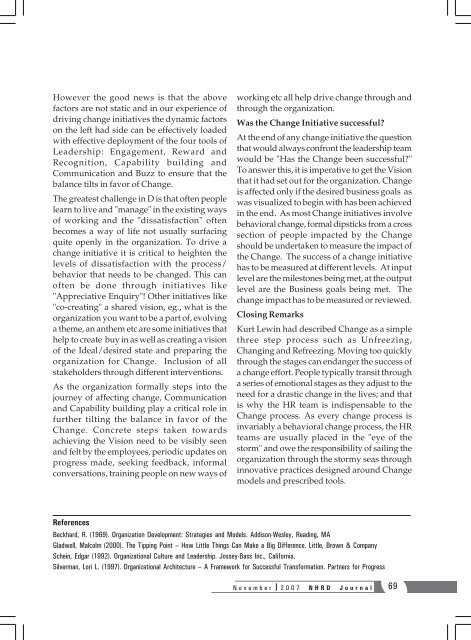NHRD Journal - National HRD Network
NHRD Journal - National HRD Network
NHRD Journal - National HRD Network
You also want an ePaper? Increase the reach of your titles
YUMPU automatically turns print PDFs into web optimized ePapers that Google loves.
However the good news is that the above<br />
factors are not static and in our experience of<br />
driving change initiatives the dynamic factors<br />
on the left had side can be effectively loaded<br />
with effective deployment of the four tools of<br />
Leadership: Engagement, Reward and<br />
Recognition, Capability building and<br />
Communication and Buzz to ensure that the<br />
balance tilts in favor of Change.<br />
The greatest challenge in D is that often people<br />
learn to live and "manage" in the existing ways<br />
of working and the "dissatisfaction" often<br />
becomes a way of life not usually surfacing<br />
quite openly in the organization. To drive a<br />
change initiative it is critical to heighten the<br />
levels of dissatisfaction with the process/<br />
behavior that needs to be changed. This can<br />
often be done through initiatives like<br />
"Appreciative Enquiry"! Other initiatives like<br />
"co-creating" a shared vision, eg., what is the<br />
organization you want to be a part of, evolving<br />
a theme, an anthem etc are some initiatives that<br />
help to create buy in as well as creating a vision<br />
of the Ideal/desired state and preparing the<br />
organization for Change. Inclusion of all<br />
stakeholders through different interventions.<br />
As the organization formally steps into the<br />
journey of affecting change, Communication<br />
and Capability building play a critical role in<br />
further tilting the balance in favor of the<br />
Change. Concrete steps taken towards<br />
achieving the Vision need to be visibly seen<br />
and felt by the employees, periodic updates on<br />
progress made, seeking feedback, informal<br />
conversations, training people on new ways of<br />
working etc all help drive change through and<br />
through the organization.<br />
Was the Change Initiative successful?<br />
At the end of any change initiative the question<br />
that would always confront the leadership team<br />
would be "Has the Change been successful?"<br />
To answer this, it is imperative to get the Vision<br />
that it had set out for the organization. Change<br />
is affected only if the desired business goals as<br />
was visualized to begin with has been achieved<br />
in the end. As most Change initiatives involve<br />
behavioral change, formal dipsticks from a cross<br />
section of people impacted by the Change<br />
should be undertaken to measure the impact of<br />
the Change. The success of a change initiative<br />
has to be measured at different levels. At input<br />
level are the milestones being met, at the output<br />
level are the Business goals being met. The<br />
change impact has to be measured or reviewed.<br />
Closing Remarks<br />
Kurt Lewin had described Change as a simple<br />
three step process such as Unfreezing,<br />
Changing and Refreezing. Moving too quickly<br />
through the stages can endanger the success of<br />
a change effort. People typically transit through<br />
a series of emotional stages as they adjust to the<br />
need for a drastic change in the lives; and that<br />
is why the HR team is indispensable to the<br />
Change process. As every change process is<br />
invariably a behavioral change process, the HR<br />
teams are usually placed in the "eye of the<br />
storm" and owe the responsibility of sailing the<br />
organization through the stormy seas through<br />
innovative practices designed around Change<br />
models and prescribed tools.<br />
References<br />
Beckhard, R. (1969). Organization Development: Strategies and Models. Addison-Wesley, Reading, MA<br />
Gladwell, Malcolm (2000). The Tipping Point – How Little Things Can Make a Big Difference. Little, Brown & Company<br />
Schein, Edgar (1992). Organizational Culture and Leadership. Jossey-Bass Inc., California.<br />
Silverman, Lori L. (1997). Organizational Architecture – A Framework for Successful Transformation. Partners for Progress<br />
November 2007 <strong>N<strong>HRD</strong></strong> <strong>Journal</strong> 69
















